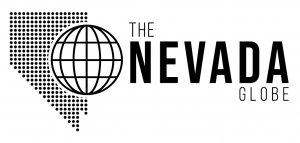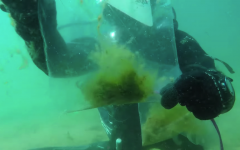
Overlooking Lake Tahoe on the Tunnel Creek Trail where a bench is dedicated to Mark Twain (Photo: The Nevada Globe Editor for The Nevada Globe)
Not Twain’s Tahoe: Raw Sewage, Microplastics and Lead Telecom Lines Litter Lake Tahoe
Raw sewage and weekend-warrior trash are not the only poisons that threaten the health of the lake and its inhabitants
By Ashleigh Lynn Goodwin, July 24, 2024 12:34 pm
On July 19, North Tahoe Public Utility District estimated that 125,000 gallons of untreated sewage were “discharged” from a break in a sewer line, of which only 40,000 gallons were recovered. An estimated 85,000 gallons of raw sewage seeped into the lake from the shore of Carnelian Bay West Beach. The contaminated water samples have been collected and sent to be tested, but the current levels still need to be determined.
According to the Environmental Protection Agency, raw sewage in bodies of water “has the potential to impair water quality, adversely affect aquatic environments and increase risks to human health…the impacts may be especially problematic in marinas, slow-moving rivers, lakes and other bodies of water with low-flushing rates.”
At the time when Mark Twain spoke in prose of the “noble sheet of Blue Water lifted six thousand three hundred feet above the level of the sea,” today’s Tahoe is not Twain’s Tahoe while he was reporting from the foothills of Virginia City, Nevada.
Today’s Tahoe trails are littered with waste. Beach-goers leave their party wreckage near the water’s edge, and trash receptacles of all sizes are overfilled with refuse. The unsecured dumpsters serve as buffets for local urbanized black bears and other scavenging creatures who call this place “Tahome.”
Unfortunately, sewage and weekend-warrior trash are not the only poisons that threaten the health of the lake and its inhabitants. Microplastics and eight miles of lead-based AT&T communication cables beneath the surface have been found in the jewel of the Sierra.
Keep Tahoe Blue
Many agencies, individuals, and even a lengthy stewardship plan are devoted to the same goal of preserving the pristine waters of Lake Tahoe and the forested lands and trails that encircle it.
Keep Tahoe Blue League, “The League” to “Save Lake Tahoe,” self-designates as “the Lake’s strongest environmental watchdog,” and, according to the website “proactively identify problems and find solutions, using science and innovation to take rapid action.” One such pilot program named “Tahoe Blue Beaches” had a positive impact on the status of Zephyr Shoals after the ¾ mile strip of sand made headlines in July 2023 as nearly 9,000 pounds of trash was collected during what became known as the “hangover cleanup”.
Multiple cleanups, lobbying efforts, and year-round marketing drive the nonprofit’s tireless efforts. Yet, almost 2,000 pounds of trash was collected during the 11th annual “5th of July Clean Up” despite aggressive social media campaigns, the addition of portable restrooms and trash receptacles, and increasing staff to “encourage people to do the right thing.”
Thankfully, The League is not the only agency making a big impact on the lake. Clean Up The Lake has amassed volunteers to dive below the surface 415 times to retrieve what wasn’t collected by the land-based watchdog. The amphibious 501-C3 nonprofit has collected 7,812 pounds of trash above the surface and an astounding 63,487 pounds of trash below the surface.
Additionally, the USDA Forest Service has joined forces with a worldwide food and services provider to work on maintaining the high-traffic beach known for massive cleanup efforts. They also assist in reducing brawls between rowdy and trashy visitors.
“We are grateful to the League, USDA Forest Service Lake Tahoe Basin Management Unit (LTBMU) and other partners who have collaborated closely with our team to ensure a safe and sustainable holiday weekend for Tahoe beachgoers and local residents,” said Aramark Destinations District Manager Kevin Schiesz in a statement. “Incorporating the Zephyr Shoals area into our operations is an honor, and we look forward to continuing our decades-long partnership with the LTBMU to safeguard the beach and enhance the visitor experience for future generations.”

Microplastics and Getting The Lead Out
In January 2023, a floating dock exploded under the weight of the waves leaving behind “beads [which] looked like snow that had settled into drifts around the beach,” the Tahoe Daily Tribune reported. Co-author Sudeep Chandra of the Global Water Center at UNR published a July 2023 report that identified high levels of microplastics in the lake. That same month, the Wall Street Journal asserted that “America is wrapped in miles of toxic lead cables.”
According to The League, removal of the toxic lead cables was on track to occur in September 2023 before AT&T claimed “sensationalized media reports” were published. In May 2024, Moonshine Ink reported “AT&T backtracks on removing lead cables amid legal fight”
“The League mapped the location of lead telecommunication cables and worked with its agency partners to expedite the permits and contracts needed for the work to get underway.” Director of Communications for The League Chris Joseph told The Globe.
Yet, according to a court filing by AT&T’s on July 11, 2023, “the parties remain at an ‘impasse’ regarding removal of the cables at Lake Tahoe.”
The lawsuit between California Sportfishing Protection Alliance and Pacific Bell Telephone Company (AT&T) sits tied up in court leaving “a dangerous recycling project sitting at the bottom of the lake for long enough” according to the Tahoe Lead Removal project leader Evan Dreyer.
“Tahoe is such a unique phenomenon within the broader spectrum of lakes in the country and is a reason to err on the side of protecting it – safeguarding it for generations to come,” Dreyer said. “On July 3 [2024], we conducted a site visit to the decommissioned lead cables. We view these surveys as appropriate throughout the duration of the project to document the state of the cables, as well as observe how the dynamic lake environment will influence our project.”
AT&T maintains there is no reason to believe that the antiquated cables “pose a public health risk or a risk to workers when appropriate safety measures are in place,” yet their website also states they “offer blood testing to workers who work on or have come into contact with lead-clad cables, at no cost.”
AT&T’s legal team argues: “Because lead is a heavy metal, any lead from limited leaching that may occur tends to settle out of the water—rather than dissolve into it. Lead tends to bond with organic matter in the sediment to form insoluble compounds that do not mix with water. In the context of Lake Tahoe, one of the largest lakes in the United States, what little lead from telecom cables could potentially dissolve would be naturally diluted by the vast quantities of water in the lake (tens of trillions of gallons). As a result, and as confirmed by AT&T’s testing, any lead leaching from the cables in Lake Tahoe does not have a significant impact on public health or the environment.”
“To me, this statement uses the size of the lake against itself,” Dreyer argued. “It doesn’t matter how much lead, if any, is being emitted because the cable houses multiple components that make it a recyclable recovery project.”
The seven agencies tasked to remove the cables include Lahontan Regional Water Quality Control Board, Tahoe Regional Planning Agency, California Fish & Wildlife, California State Parks, California State Lands Commission, U.S. Army Corps of Engineers, and US Forest Service.
“The Lake is too important, too special to have eight miles of trash left at the bottom of it. The cables need to come out immediately. The League is supportive of efforts to remove the cables from the Lake, including Tahoe Lead’s ongoing work. Our staff are in frequent contact with Tahoe Lead about their work,” said The League in a statement.
This is a developing story.
- AT&T Finally Gets The Lead Out of Lake Tahoe - November 13, 2024
- New Barton Hospital Location Divides South Shore Community - September 5, 2024
- Allegations of Racism in Virginia City Prompts Investigation - August 5, 2024






